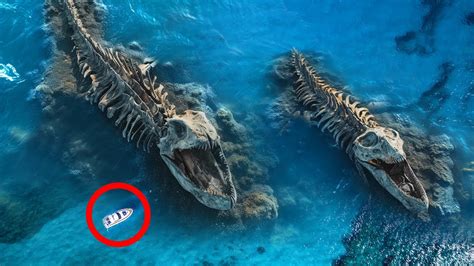
Once believed extinct, the nautilus, a cephalopod species with origins dating back 500 million years, has been captured on camera in waters off Ndrova Island in Papua New Guinea, stunning researchers who feared the species had vanished due to overfishing and habitat degradation.
For over a month, a research team led by Peter Ward, a University of Washington professor who first studied nautiluses in Papua New Guinea back in 1984, had been searching for the elusive Allonautilus scrobiculatus, a nautilus species characterized by its distinctively hairy shell and thick, slimy periostracum (outer shell layer). The team set baited camera rigs at depths between 500 and 1,300 feet, hoping to entice the rare creature into view. Ward explained, “We started using baited remote cameras in 2015 to survey for Allonautilus after scientists suggested the species might be endangered due to overfishing. Initially, we were only finding common nautiluses.”
The turning point came when one of the cameras finally captured footage of Allonautilus scrobiculatus. “It was an amazing moment,” Ward recounted. “We had spent so much time and effort, and there it was, right in front of the camera.” This rediscovery is crucial for conservation efforts, as it provides a basis for understanding the species’ current distribution and population size.
The nautilus is often referred to as a “living fossil” because its morphology has remained largely unchanged for hundreds of millions of years. This makes it a unique window into the deep past and offers insights into the evolution of cephalopods and marine life in general. The Allonautilus genus is particularly intriguing because it represents a separate evolutionary branch from the more common Nautilus genus.
Ward emphasized the importance of this rediscovery, stating, “Finding Allonautilus again is a testament to the resilience of life and a call to action to protect these ancient creatures and their fragile habitats.” He also highlighted the need for further research to understand the species’ behavior, ecology, and conservation status.
The rediscovery has sparked renewed interest in nautilus conservation, with researchers and conservationists calling for stricter regulations on fishing and habitat protection in the regions where these creatures are found. The long-term survival of the nautilus depends on collaborative efforts to mitigate threats and ensure the preservation of its deep-sea environment.
Background on Nautiluses
Nautiluses are ancient marine creatures belonging to the cephalopod class, which also includes squids, octopuses, and cuttlefish. They are characterized by their coiled shells, which are divided into chambers that the nautilus uses to control its buoyancy. These chambers are connected by a tube called the siphuncle, which allows the nautilus to regulate the amount of gas and fluid in each chamber, enabling it to move up and down in the water column.
Unlike their cephalopod relatives, nautiluses have a simple eye structure without a lens, resembling a pinhole camera. They also possess numerous tentacles (around 90), which lack suckers and are used for grasping prey. Nautiluses are primarily scavengers and predators, feeding on crustaceans, small fish, and carrion.
There are currently six recognized species of nautiluses, divided into two genera: Nautilus and Allonautilus. The Allonautilus genus is distinguished by its hairy shell and unique shell morphology. These nautiluses are found in specific regions of the Pacific Ocean, including Papua New Guinea, the Solomon Islands, and Vanuatu.
The Significance of Allonautilus scrobiculatus
Allonautilus scrobiculatus is a particularly rare and elusive species of nautilus. It was first described in the late 19th century, but sightings have been infrequent, and little is known about its biology and ecology. The species is characterized by its distinctive hairy shell, which is covered in a thick, slimy layer called the periostracum. This layer is thought to help protect the shell from abrasion and fouling organisms.
The rediscovery of Allonautilus scrobiculatus is significant for several reasons. First, it confirms that the species is still extant, despite concerns about overfishing and habitat degradation. Second, it provides an opportunity to study the species in its natural habitat and learn more about its behavior, ecology, and conservation needs. Third, it highlights the importance of continued research and monitoring efforts to assess the status of rare and endangered species.
Threats to Nautiluses
Nautiluses face a number of threats, including overfishing, habitat degradation, and climate change. Overfishing is a major concern because nautiluses are slow-growing and late-maturing, making them vulnerable to population depletion. Their shells are also highly prized by collectors, leading to unsustainable harvesting practices.
Habitat degradation, such as pollution and sedimentation, can also negatively impact nautiluses by affecting their food sources and reproductive success. Climate change is another potential threat, as rising ocean temperatures and ocean acidification could disrupt their physiology and habitat.
Conservation Efforts
Given the threats facing nautiluses, conservation efforts are essential to ensure their long-term survival. These efforts include:
- Fishing Regulations: Implementing stricter regulations on nautilus fishing, such as catch quotas and size limits, to prevent overexploitation.
- Habitat Protection: Establishing marine protected areas in regions where nautiluses are found to protect their habitats from degradation.
- Sustainable Harvesting Practices: Promoting sustainable harvesting practices that minimize the impact on nautilus populations.
- Research and Monitoring: Conducting research to better understand the biology, ecology, and conservation needs of nautiluses, and monitoring their populations to assess their status.
- Public Awareness: Raising public awareness about the importance of nautilus conservation and the threats they face.
- International Collaboration: Encouraging international collaboration to coordinate conservation efforts and address transboundary threats.
The rediscovery of Allonautilus scrobiculatus serves as a reminder that even species thought to be extinct can sometimes reappear, offering hope for conservation and a renewed impetus to protect the world’s biodiversity.
Details of the Expedition
Professor Peter Ward’s research team embarked on their expedition with specific goals and methodologies in mind. The primary objective was to locate and document the presence of Allonautilus scrobiculatus in the waters off Ndrova Island, Papua New Guinea. This involved deploying baited camera rigs at various depths to attract the elusive nautiluses.
The team selected Ndrova Island based on historical records and local knowledge suggesting that Allonautilus scrobiculatus had been observed in the area in the past. They strategically placed the camera rigs at depths ranging from 500 to 1,300 feet, where nautiluses are known to inhabit. The cameras were equipped with bait to lure the nautiluses into the field of view.
The team spent over a month monitoring the camera rigs, carefully reviewing the footage captured each day. The initial findings revealed the presence of common nautiluses, but the team remained hopeful that they would eventually encounter Allonautilus scrobiculatus. Their persistence paid off when one of the cameras captured footage of the rare species, confirming its continued existence in the area.
The expedition also involved collecting data on the environmental conditions in the study area, such as water temperature, salinity, and oxygen levels. This information will help researchers understand the habitat preferences of Allonautilus scrobiculatus and the factors that may influence its distribution and abundance.
Implications for Evolutionary Biology
The nautilus holds a unique position in evolutionary biology due to its ancient lineage and relatively unchanged morphology. As a “living fossil,” it provides a glimpse into the deep past and offers insights into the evolution of cephalopods and marine life.
The rediscovery of Allonautilus scrobiculatus further enhances the significance of nautiluses in evolutionary studies. This species represents a distinct evolutionary branch from the more common Nautilus genus, suggesting that nautiluses have diversified over time to occupy different ecological niches.
By studying the genetic makeup, morphology, and behavior of Allonautilus scrobiculatus, researchers can gain a better understanding of the evolutionary processes that have shaped nautiluses and other cephalopods. This knowledge can also shed light on the broader patterns of evolution in marine ecosystems.
The Role of Technology in the Rediscovery
The rediscovery of Allonautilus scrobiculatus would not have been possible without the use of advanced technology. Baited camera rigs played a crucial role in capturing footage of the elusive nautiluses in their deep-sea habitat.
These camera rigs are equipped with high-resolution cameras and powerful lights that can operate in the dark depths of the ocean. They are also designed to withstand the immense pressure at these depths. The bait used in the rigs attracts the nautiluses into the field of view, allowing researchers to observe and document their behavior.
The use of remote cameras is particularly important for studying deep-sea creatures like nautiluses because it minimizes disturbance to their natural environment. Traditional methods of observation, such as submersible dives, can be disruptive and may alter the behavior of the animals being studied.
The technology used in the rediscovery of Allonautilus scrobiculatus demonstrates the potential of innovative tools for exploring and understanding the deep sea. As technology continues to advance, we can expect to see even more discoveries of rare and elusive marine species.
Local Perspectives and Community Involvement
The rediscovery of Allonautilus scrobiculatus has generated excitement not only among scientists but also among local communities in Papua New Guinea. The nautilus holds cultural significance for many coastal communities, and its rediscovery has sparked renewed interest in its conservation.
Local communities can play a vital role in nautilus conservation by providing valuable insights into the species’ distribution, behavior, and habitat. They can also assist with monitoring efforts and help to enforce fishing regulations.
Engaging local communities in conservation efforts is essential for ensuring the long-term survival of nautiluses. By working together, scientists, conservationists, and local communities can protect these ancient creatures and their fragile habitats.
Future Research Directions
The rediscovery of Allonautilus scrobiculatus has opened up new avenues for research on nautiluses. Future research directions include:
- Population Assessment: Conducting surveys to estimate the population size and distribution of Allonautilus scrobiculatus.
- Behavioral Studies: Observing the behavior of Allonautilus scrobiculatus in its natural habitat to learn more about its feeding habits, social interactions, and reproductive strategies.
- Genetic Analysis: Analyzing the genetic makeup of Allonautilus scrobiculatus to understand its evolutionary history and relationships to other nautilus species.
- Habitat Mapping: Mapping the habitat of Allonautilus scrobiculatus to identify critical areas for conservation.
- Threat Assessment: Assessing the threats facing Allonautilus scrobiculatus, such as overfishing, habitat degradation, and climate change.
- Conservation Planning: Developing and implementing conservation plans to protect Allonautilus scrobiculatus and its habitat.
These research efforts will provide valuable information for guiding conservation actions and ensuring the long-term survival of this rare and elusive species.
The Importance of Deep-Sea Conservation
The rediscovery of Allonautilus scrobiculatus underscores the importance of deep-sea conservation. The deep sea is one of the least explored and most vulnerable ecosystems on Earth. It is home to a vast array of unique and often bizarre creatures, many of which are still unknown to science.
The deep sea is also increasingly threatened by human activities, such as fishing, mining, and pollution. These activities can have devastating impacts on deep-sea ecosystems, which are slow to recover from disturbance.
Conserving the deep sea is essential for protecting biodiversity, maintaining ecosystem services, and ensuring the long-term health of the planet. This requires a concerted effort from scientists, conservationists, policymakers, and the public to reduce human impacts on deep-sea ecosystems and promote sustainable management of deep-sea resources.
The rediscovery of Allonautilus scrobiculatus serves as a reminder of the hidden wonders that lie in the deep sea and the importance of protecting these fragile ecosystems for future generations.
The Media’s Role in Conservation
The media plays a critical role in raising public awareness about conservation issues. By reporting on stories like the rediscovery of Allonautilus scrobiculatus, the media can help to educate the public about the importance of biodiversity and the threats facing endangered species.
The media can also help to promote conservation efforts by highlighting the work of scientists, conservationists, and local communities who are working to protect threatened species and ecosystems. By giving a voice to these individuals and organizations, the media can inspire others to get involved in conservation.
In addition to reporting on success stories, the media also has a responsibility to report on the challenges facing conservation. This includes highlighting the threats facing endangered species, the impacts of human activities on ecosystems, and the need for stronger conservation policies.
By providing accurate and informative coverage of conservation issues, the media can help to create a more informed and engaged public, which is essential for promoting effective conservation action.
The Future of Nautiluses
The future of nautiluses remains uncertain, but the rediscovery of Allonautilus scrobiculatus offers a glimmer of hope. With concerted conservation efforts, it is possible to protect these ancient creatures and ensure their long-term survival.
The key to nautilus conservation is to reduce the threats they face, such as overfishing, habitat degradation, and climate change. This requires a multi-faceted approach that includes:
- Strengthening fishing regulations: Implementing stricter regulations on nautilus fishing to prevent overexploitation.
- Protecting critical habitats: Establishing marine protected areas in regions where nautiluses are found to protect their habitats from degradation.
- Promoting sustainable harvesting practices: Encouraging sustainable harvesting practices that minimize the impact on nautilus populations.
- Addressing climate change: Reducing greenhouse gas emissions to mitigate the impacts of climate change on nautiluses and other marine species.
- Raising public awareness: Educating the public about the importance of nautilus conservation and the threats they face.
By taking these actions, we can help to ensure that nautiluses continue to roam the oceans for generations to come. The story of Allonautilus scrobiculatus is a reminder that even species thought to be lost can be rediscovered, offering hope for conservation and a renewed commitment to protecting the world’s biodiversity. The challenge now is to translate this hope into action and ensure that nautiluses thrive in the future.
FAQ Section:
1. What exactly is Allonautilus scrobiculatus?
- Allonautilus scrobiculatus is a rare and elusive species of nautilus, a type of cephalopod (related to squids and octopuses) characterized by its coiled shell. It is distinguished from other nautilus species by its hairy shell, which is covered in a thick, slimy layer called the periostracum. It is considered a “living fossil” because its basic body plan has remained largely unchanged for millions of years.
2. Why was it thought to be extinct?
- While not officially declared extinct, Allonautilus scrobiculatus had become extremely rare, with very few sightings in recent decades. Scientists feared that overfishing for their shells and habitat degradation might have led to its extinction or near-extinction. The lack of recent documented sightings fueled these concerns.
3. Where was Allonautilus scrobiculatus rediscovered?
- The Allonautilus scrobiculatus was rediscovered in the waters off Ndrova Island in Papua New Guinea. This is the same area where it was first studied by Professor Peter Ward back in 1984.
4. How did scientists rediscover Allonautilus scrobiculatus?
- Scientists used baited remote camera rigs deployed at depths between 500 and 1,300 feet. These cameras were left to record footage over a month, and after reviewing the footage, they found conclusive evidence of Allonautilus scrobiculatus. The bait attracted the nautiluses, allowing the cameras to capture clear images of the species.
5. What are the implications of this rediscovery for conservation?
- The rediscovery of Allonautilus scrobiculatus highlights the resilience of life and the importance of continued research and conservation efforts. It provides a basis for understanding the species’ current distribution and population size, which is crucial for developing effective conservation strategies. It also underscores the need for stricter regulations on fishing and habitat protection in the regions where these creatures are found to ensure their long-term survival. The rediscovery also brings awareness to deep-sea conservation, as nautiluses face threats like overfishing and habitat degradation.
Elaboration on Threats to Nautiluses
The primary threats to nautiluses stem from human activities, primarily driven by economic factors and a lack of sufficient regulation and conservation efforts. Understanding these threats in detail is crucial for devising effective protective measures.
1. Overfishing and Shell Trade:
- The most significant threat to nautiluses is overfishing, driven by the demand for their aesthetically appealing shells. These shells are sold as souvenirs, decorative items, and in some cases, used in jewelry making. The fishing methods employed are often unsustainable, leading to significant population declines.
- Nautiluses are particularly vulnerable to overfishing due to their life history traits:
- Slow Growth Rate: Nautiluses grow very slowly, taking many years to reach maturity.
- Late Maturity: They also mature late in life, meaning they reproduce for the first time at a relatively older age.
- Low Reproductive Rate: Nautiluses lay only a small number of eggs each year, and the survival rate of these eggs is often low.
- These factors combine to make nautilus populations slow to recover from overfishing. Once a population is depleted, it can take decades for it to rebound, if it rebounds at all.
- The lack of comprehensive monitoring and enforcement of fishing regulations in many regions where nautiluses are found exacerbates the problem. Illegal fishing and unregulated harvesting continue to threaten their populations.
2. Habitat Degradation:
- Nautiluses are also threatened by habitat degradation, which can result from a variety of human activities, including:
- Pollution: Pollution from industrial and agricultural sources can contaminate the waters where nautiluses live, affecting their health and reproductive success.
- Sedimentation: Sedimentation from deforestation and coastal development can smother nautilus habitats, burying their feeding grounds and spawning sites.
- Destructive Fishing Practices: Bottom trawling, a fishing method that involves dragging heavy nets across the seafloor, can destroy the benthic habitats where nautiluses find food and shelter.
- Ocean Acidification: Increasing levels of carbon dioxide in the atmosphere are causing the oceans to become more acidic. This can make it difficult for nautiluses to build and maintain their shells, which are made of calcium carbonate.
3. Climate Change:
- Climate change poses a long-term threat to nautiluses, primarily through rising ocean temperatures and ocean acidification.
- Rising Ocean Temperatures: Nautiluses are adapted to live in a relatively narrow range of water temperatures. Rising ocean temperatures can stress them, making them more susceptible to disease and less able to reproduce.
- Ocean Acidification: As mentioned above, ocean acidification can make it difficult for nautiluses to build and maintain their shells.
4. Bycatch:
- Nautiluses are sometimes caught as bycatch in fisheries targeting other species. This can occur when nautiluses become entangled in fishing gear, such as nets and lines. Bycatch can contribute to nautilus mortality and further deplete their populations.
5. Limited Geographic Range:
- Many nautilus species have a limited geographic range, making them particularly vulnerable to localized threats. If a single population is wiped out by overfishing or habitat degradation, it can be difficult or impossible for the species to recover.
Addressing these threats requires a comprehensive and collaborative approach involving governments, scientists, conservation organizations, and local communities. This includes implementing stricter fishing regulations, protecting critical habitats, promoting sustainable harvesting practices, and addressing climate change.
Further Context on Nautilus Morphology and Biology
To fully appreciate the significance of the Allonautilus scrobiculatus rediscovery, it’s helpful to delve deeper into the unique morphology and biology of nautiluses.
1. The Shell:
- The nautilus shell is perhaps its most distinctive feature. It is a coiled, chambered structure made of calcium carbonate. The shell provides protection for the nautilus’s soft body and also plays a crucial role in buoyancy control.
- The shell is divided into chambers by septa, which are thin walls of calcium carbonate. The nautilus occupies only the outermost chamber, called the living chamber. As the nautilus grows, it adds new chambers to the shell, sealing off the previous chambers.
- The chambers are connected by a tube called the siphuncle, which runs through the center of the shell. The siphuncle allows the nautilus to regulate the amount of gas and fluid in each chamber, enabling it to control its buoyancy and move up and down in the water column.
- The shell of Allonautilus scrobiculatus is distinguished by its hairy periostracum, which is a thin, organic layer that covers the outer surface of the shell. The periostracum is thought to help protect the shell from abrasion and fouling organisms.
2. Sensory Systems:
- Nautiluses have relatively simple sensory systems compared to other cephalopods. They have eyes that lack a lens, similar to pinhole cameras. These eyes provide them with limited visual acuity but are still useful for detecting light and movement.
- Nautiluses also have numerous tentacles (around 90) that lack suckers. These tentacles are covered in ridges and grooves that are sensitive to touch and chemicals. The tentacles are used for grasping prey and exploring the environment.
3. Locomotion:
- Nautiluses move through the water by jet propulsion. They expel water from a funnel located near their head, which propels them forward. They can also use their tentacles to crawl along the seafloor.
4. Diet and Feeding:
- Nautiluses are primarily scavengers and predators. They feed on crustaceans, small fish, and carrion. They use their tentacles to grasp prey and bring it to their mouth, which is equipped with a beak-like structure for crushing shells and bones.
5. Reproduction:
- Nautiluses have a complex reproductive cycle that is still not fully understood. They are thought to reproduce only once in their lifetime (semelparous).
- Females lay relatively few eggs, which are attached to rocks or other substrates. The eggs take a long time to hatch (up to a year), and the hatchlings are small and vulnerable.
Understanding these aspects of nautilus morphology and biology is essential for developing effective conservation strategies and ensuring the long-term survival of these ancient creatures. The unique adaptations of nautiluses make them particularly vulnerable to environmental changes, highlighting the need for proactive conservation measures.









